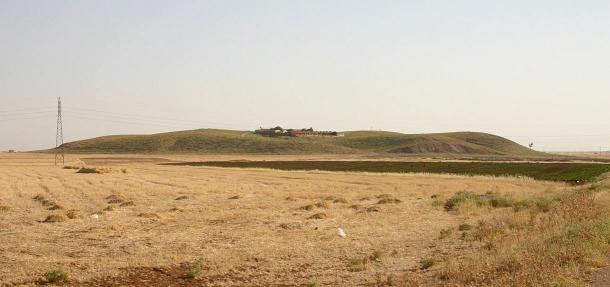
The Rediscovery of Urkesh: Forgotten City of the Hurrians
Ancient Urkesh was once a major hub of the ancient Near Eastern Hurrian civilization, known in mythology as the home of a primordial god. Little was known about Urkesh and the mysterious Hurrian civilization, as the ancient city had remained buried beneath desert sands for thousands of years, lost to the pages of history. However, in the 1980s, archaeologists discovered Tell Mozan, a towering mound that hid the remains of an ancient palace, temple, and plaza. A decade later, and researchers made the exciting realization that Tell Mozan was the lost city of Urkesh.
Located in what is now northern Syria, near its current borders with Turkey and Iraq, ancient Urkesh was once a large Mesopotamian city that flourished between 4000 and 1300 B.C. It is one of the earliest known cities in history and displayed quite a different model of urbanization to the Sumerians.
The powerful city of Urkesh
Urkesh was once a major political and religious center of the Hurrians, and an important stop on both the north-south trade route between Anatolia and the cities of Syria and Mesopotamia, and the east-west route that linked the Mediterranean with the Zagros Mountains of western Iran. Urkesh was also the capital of a kingdom that controlled the highlands immediately to the north where the supplies of copper were located, which made the city wealthy and rich.

View of Tell Mozan (northeast Syria), ancient Urkesh, from the north. The dighouse can be seen in the middle of the tell. (Wikimedia Commons)
The elusive Hurrians
The people who built the city, the Hurrians, were a small, elusive, but influential civilization of the ancient Near East. Until the discovery of Tell Mozan, the Hurrians were known primarily from the second millennium; scholars assumed that that was when they first came into the region. The discovery of Urkesh, however, pushed back the earliest evidence for the Hurrians well into the third millennium. Previously, knowledge about the Hurrians was limited to ancient legends, and a small number of artifacts of unknown origin.
Excavations revealed compelling evidence that the Hurrians not only strongly influenced the language, culture, and religion of later peoples, but may have been present when nearby Mesopotamians were beginning to create the first cities. The most distinctive trait of the Hurrians was their language, which was wholly unique and unrelated to any other known ancient or living language.
- Ancient song recreated from 3,400-year-old cuneiform tablets
- The Rise and Fall of Sumer and Akkad
- The Fierce Amorites and the First King of the Babylonian Empire

An Urkish lion and accompanying stone tablet bearing the earliest known text in Hurrian. The inscription reads: "Tishatal, [Endan] king of Urkesh, has built a temple for the god Nergal. May the god Nubadag protect this temple. May Nubadag destroy whomsoever seeks to destroy [it]; may his god not listen to his prayers. May the Lady of Nagar, [the sun god] Shimiga, and the god of the storm [curse 10,000 times whomsoever might seek to destroy it]." (Wikimedia Commons).
The exploration of Tell Mozan
The investigation of Tell Mozan began in the 1980s, but it took almost a decade before archaeologists were able to definitively identify the site as the lost city of Urkesh.
The excavations revealed most of what is known today about the early culture of the Hurrian people. Upon excavation, the site revealed not only mud-brick architecture, but also rare stone structures. The uncovered remains of this fabled ancient city have revealed an open plaza, a monumental flight of stairs and a deep underground shaft – the 'Passage to the Netherworld’ which was related to religious rituals.
Urkesh housed monumental public buildings, including a large temple. It dominated the ancient skyline at the top of a built-up terrace that rivaled nearby mountains. A large royal palace, currently under excavation, has yielded written evidence that has been able to identify this ancient city. Many of these findings have been dated to the Akkadian period (ca. 2350–2200 B.C.)

A staircase unearthed at Tell Mozan (Met Museum)
Ancient seals provide a window into life in Urkesh
The Urkesh/Tell Mozan excavations have also yielded a large amount of seal impressions, which were once placed on boxes, jars and baskets. Some of these impressions were also used to seal doors of buildings or individual storerooms. Over a thousand impressions made from rolling over 100 different seals have been found. Of these impressions, about 150 contain seal inscriptions. In addition, a number of cuneiform tablets from the Old Akkadian period have been excavated; they include for the most part administrative texts, but also school texts, one with a portion of a Sumerian dictionary.
Hundreds of clay seals with depictions of the life and lore of the royal family have uncovered important information about the site’s history. Written documents from the Palace have given us the name, not only of the city and kingdom of Urkesh, but also of its king, Tupkish, and queen, Uqnitum. The documents state that one of the daughters of Naram-Sin, the famous Mesopotamian king, lived in Urkesh. Five seals belong to one of the kings of Urkesh, named Tupkish, eight to his queen, Uqnitum, and five more to courtiers connected with their household.

A Hurrian seal found at Urkesh (UCLA)
As of now, no other archaeological site can claim the same type of evidence for Hurrian identity as Urkesh. To some extent, this is because there were probably only a few Hurrian cities distributed along what is now northern Syria. The Hurrians built a civilization that proved to be very influential for the whole of the ancient Near East.
In the third millennium, the Hurrians developed an alternative model to the southern urban experiment of the Sumerians, a model based on ethnic identity more than territorial contiguity. The cultural uniqueness of Urkesh is due in part to its geographical uniqueness: against the backdrop of the mountains, it combined the urban potential of the plains with the ability to exploit less easily accessible resources of the highlands. This contributed to its unique religious and political traditions, and safeguarded it from the aggressive expansionism of the Akkadian Empire. The Akkadian king, Naram-Sin, considered himself a god. Urkesh was the only major third millennium Syrian city that was not conquered by him, indicating that this city had an independence not accorded to the rest.
Finds from the excavations at Tell Mozan are on display in the Deir ez-Zor Museum in Syria. However, it is believed that many more treasures still remain hidden within deeper layers of the mound site. Sadly, excavations have been on hold since 2011 due to the Syrian Civil War and the site, like all of Syria, remains off limits to foreign archaeologists. A small team of locals guard the precious site, protecting their nation’s ancient heritage until peace prevails and excavations can resume.
Featured image: The Royal Palace of Urkesh, built around 2250 B.C. by king Tupkish. (Archaeological Institute of America).
References
"Tell Mozan Urkesh." Urkesh.org. http://www.urkesh.org/attach/English A4 O908 special topics.pdf
"Archaeologist, Villagers Protect Ancient Syrian City as Civil War Rages." UCLA Newsroom. May 23, 2014. http://newsroom.ucla.edu/stories/archaeologist-villagers-protect-ancient-syrian-city-as-civil-war-rages
"Tell Mozan." World Monuments Fund. http://www.wmf.org/project/tell-mozan
"Tell Mozan (ancient Urkesh)." Barnard. http://www.barnard.nl/mozan.html
"Mysterious Urkesh And Its Elusive Civilization Of The Hurrians." MessageToEagle.com. March 4, 2015. http://www.messagetoeagle.com/urkeshtellmozan.php
"Tell Mozan, Syria." The Metropolitan Museum of Art, I.e. The Met Museum. http://www.metmuseum.org/research/archaeological-fieldwork/tell-mozan-syria
"The Modern Face of an Ancient City." Economia Della Cultura, Politiche, Governo E Gestione. http://www.ceistorvergata.it/master/beniculturali/page.php?a=121
















Comments
i hope ISIS does not destroy this, like they have destroyed Palmyra
When one has a different view, religious fundamentalists always resort to force.
Better take a good look now, because the IS will destroy it as they did Nineveh and Nimrud and one other ancient world heritage site. Because it's what Islam does best: destroys that which it replaces to remove all traces that Islam is a newcomer to the world's ideologies.